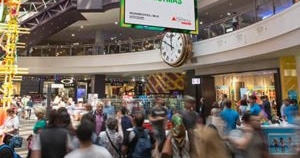Digital displays have evolved far beyond being just a mechanism for flashing advertising campaigns. Today, they can be used interactively to create a dialogue between brands and their customers. By using LED displays to create a two-way conversation, both the brand and the consumer win. A double win. The consumer is engaged in a meaningful way and offered utility in the form of a coupon, product information, or personalized service. The brand gets information about its customers that can be analyzed at both the micro and macro level. LED displays can foster customer interaction with brands primarily through mobile device interaction, motion based interaction, and sensors.
Mobile Device for Customer Interaction
Retailers are working overtime to differentiate themselves in this new digital world. With stiff competition from online retailers, companies with brick and mortar stores are trying to heighten their in-store customer experience. Their goal is to create an experience that elicits an emotional response so people will want to go into the store. To create that experience, retailers are using beacons to latch onto a customer’s smart phone and deliver hyper-targeted messages. Beacons allow retailers to curate the messages received by the customer, so he or she is only receiving information that is relevant. For example, if a man walks into a clothing store, beacons can allow the store to recognize the customer is a male and can send to his smartphone information about men’s jackets on sale. Retailers can use multiple beacons to impart multiple messages to consumers as they move through a space, like information on products, discounts, and web promotions. By triggering multiple messages, businesses have more control over their customers’ experiences.
The data gathered from the customer’s time in a store can also be analyzed individually and in the aggregate, and it allows businesses to continue to have a conversation with the customer, long after he or she has left the store.
Motion
Motion technology is camera based and allows a company to track a customer’s movement in relation to the digital display. This technology is primarily used to get a person’s attention, stop them in their tracks, and notice a marketing message – rather than for data mining.
For example, a car dealership may use a motion activated LED display to create an opportunity for a customer to have an interactive experience swiping through the various vehicle models for sale.
Motion is typically used in conjunction with beacons and text messaging in order to get more information about a customer and foster a longer-lasting relationship. An LED display might be programmed to instruct a customer to motion here for more information, and then ask the customer to put in his or her phone number or email, so a message can then be delivered to the customer’s smart phone.
Sensors
Sensors are attached to products to allow a trigger action by the LED display or to trigger other events within a store. For example, if a customer is in an athletic goods store and picks up a pair of running shoes affixed with a sensor, the nearby digital display may light up, asking the customer if she wants more information about the shoe. Or, if a male customer picks up a leather jacket at a clothing store and heads towards the dressing room, the sensor on the jacket could trigger the dressing room to play a James Dean-era song to get the customer in the right frame of mind to want to buy the jacket. The sensor could also trigger displays to suggest other products in the store, like aviator sunglasses and white t-shirts, and then allow the customer to build the cart and check out right from his smartphone.
The goal for businesses investing in LED displays is to fully leverage this investment by using the displays to have deeper, more meaningful connections with consumers or an audience. By deepening these relationships, businesses are able to get more feedback from customers and learn how to target their audiences more effectively, resulting in increased revenue. Our Nanolumens AWARE platform allows businesses to accomplish all of these goals all from one control portal. To learn how digital displays from Nanolumens can heighten your customers’ experience, please click here.
~Brice McPheeters
Business Development Manager

